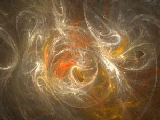
Purpose
To physically see the water that exists in the air through the process of condensation.
Additional information
The atmosphere is like a river full of water, only we can't see it. Water exists in a gaseous state in the atmosphere, almost like it's shrouded in a cloak of invisibility. Even though we can't see it, it's still there! What if there was a way to pull the water from the aid and physically see it? We can through the process of condensation!
Condensation is the change of the physical state of matter from gaseous phase into liquid phase. As a naturally occurring phenomenon, condensation can be used to generate drinkable water for human use. In fact, there have been a large number of devices created to extract water from the air, including a device that produces 600 gallons of drinkable water per day for US soldiers serving in high-heat military zones, such as IRAQ and Afghanistan.
Sponsored Links
Required materials
- Glass jar with lid
- Several ice cubes
- Table salt
- Tissue paper
Estimated Experiment Time
Less than 5 to set-up, about 30 minutes to conduct
Step-By-Step Procedure
- 1. Fill the jar with your ice cubes. There should be enough ice cubes so that they reach the top, but leave enough room so you can securely tighten the cap.
- 2. Add to heaping tablespoons of salt into the jar, covering the ice. Screw on the lid of the jar tightly.
- 3. Shake the jar vigorously for about 30 seconds.
- 4. Place the jar on a solid surface, such as a table. Leave the jar for a short while (about 10 minutes).
- 5. When you return to your jar, observe if your jar has water droplets on the outside. If it does not, leave the jar undisturbed for a while longer. When the jar does finally have visible water droplets on the outside, proceed to step 6.
- 6. Wrap your tissue around the outside of the jar, then take it off and observe how wet it is!
Note
The rate at which the droplets (known as condensation) begin to form on the outside of the jar will vary depending on the environmental conditions where the experiment is taking place.
Observation
At what point did you start to see water droplets? Can you explain what's happening? How could the water droplets be forming on the OUTSIDE of the jar when the ice is on the INSIDE of the jar, and the cap is screwed on tight? Where have you seen other natural occurrences of condensation? (here's a hint... think of what's on the ground on a cold morning).
Result
The salted ice quickly makes the sides of the glass jar very cold. As the water that exists in the air as a gas hits the cold sides of the jar, it changes into a liquid! This process is known as condensation, which is the opposite of evaporation. There is water in the air at all times, but we don't see it since it's in a gaseous state. Our experiment turns the gas into a liquid, allowing us to physically see the water.
Sponsored Links
Take a moment to visit our table of Periodic Elements page where you can get an in-depth view of all the elements,
complete with the industry first side-by-side element comparisons!